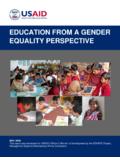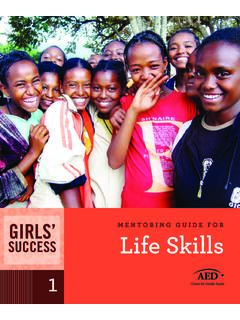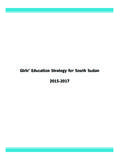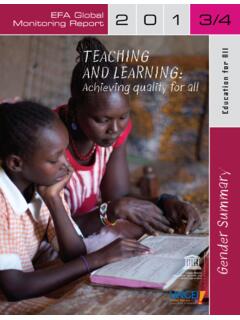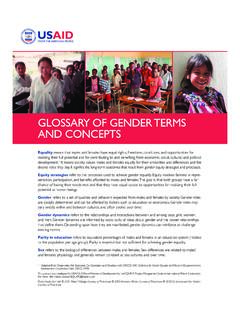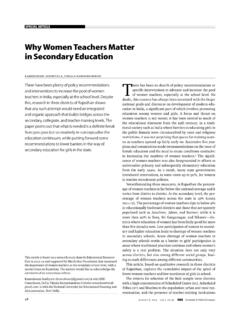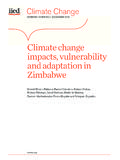Transcription of A Conceptual Overview
1 Gender Analysis in Education: A Conceptual Overview Working paper No. 05. July 2012. Gender Analysis in Education Prepared for UNGEI July 2012 United Nations Girls' Education Initiative (UNGEI) July 2012 United Nations Girls' Education Initiative (UNGEI), New York, 2012 This report is a working document. Its purpose is to facilitate rapid exchange of knowledge and perspectives and to stimulate discussion. The contents of this paper do not necessarily reflect the policies or the views of UNGEI. The paper has not been edited to official publications standards, and UNGEI accepts no responsibility for errors.
2 This report was prepared by Takudzwa Kanyangarara Beth A. Mayberry Anitha Pai and Meaghan Shanahan as part of the distance internship programme at the Harvard Graduate School Photo credit: UNICEF/NYHQ2006 2540/Pirozzi Section I: Analytical Overview Introduction Increasing attention has been given to the Box 1. Gender terms importance of achieving gender equality in Gender: The social and constructed education. To date, however, most efforts have differences in women's and men's roles and focused on addressing gender parity an equal responsibilities, which are learned, vary from number or proportion of girls and boys accessing culture to culture and change over time educational opportunities.
3 Although simple gender (Adapted from UNESCO, 2009). parity may be easier to measure, gender equality encompasses a wider concept, of which gender Sex: Biological differences between women and men (Adapted from UNESCO, 2009). parity is only a part. Gender equality moves beyond access and requires that girls and boys also Gender equality: Provision of equal experience the same levels of quality and conditions, treatment and opportunity for outcomes of education. both men and women to realize their full potential, human rights and dignity, as well as One of the key impediments to achieving gender opportunities to contribute to and benefit equality in education is that it cannot be addressed from economic, social, cultural and political in a vacuum; rather, educational institutions are development (Adapted from Status of Women products of the inequalities that exist in larger Canada, 2007).
4 Society. Educational institutions are shaped by the Gender mainstreaming: The process used to societal forces that perpetuate gender based ensure that women's and men's concerns and discrimination; yet, they can also be essential tools experiences are integral to the design, to effect great change throughout a community or implementation, monitoring and evaluation of social context. Behaviours and beliefs formed in all legislation, policies and programmes. This schools and educational institutions can have a leads to equal benefits for women and men, lasting impact on gender relations in society.
5 And ends the perpetuation of existing Education systems are both a result of external inequality (Adapted from the United Kingdom's Department for International forces and instrumental to perpetuating or Development (DFID), 2002). alleviating gender disparity around the world. Gender parity: A numerical concept While gender equality in education necessitates concerned with the relative equality in terms that girls and boys have equitable educational of numbers and proportions of women, men, conditions, treatment and opportunities, girls and boys. In education, this means that policymakers and practitioners have different the same number of boys and girls receive educational services at different levels and in rationales for improvement.
6 The need to address diverse forms (Adapted from UNESCO, 2009; gender inequality permeates the Millennium UNICEF 2012). Development Goals (MDGs), United Nations Educational, Scientific and Cultural Organization (UNESCO) Education for All (EFA) goals, and and development agency policy and practice. Yet, monitoring and evaluation reasons for gender equality range from arguments of education policies and programmes takes into for social and economic efficiency to the fulfilment account existing gender disparities. It creates the of human rights and/or empowerment of girls and opportunity for users to address gender women.
7 Needs throughout the life cycle of the intervention. By illuminating differences of gender, Gender analysis is a prerequisite to ensuring that it allows users to evaluate the way in which every step of design, planning, implementation interventions will impact gender roles, relations or responsibilities. In order to ensure the effective 3. planning and implementation of gender analysis, it to economic growth and social efficiency. For is essential that all stakeholders use common example, WID advocates for investments in girls' language and have a shared understanding of education, citing increased societal benefits such gender terms.
8 A few of the key terms are defined as reduced child mortality rates, reduced fertility in Box 1. rates and increased gross domestic product per capita. The WID approach is prominently featured This document consists of two sections: an in the concept of gender parity, the notion that an analytical Overview and an annotated bibliography. equal proportion of girls and boys should be The analytical Overview of gender analysis in enrolled in and complete schooling (Canadian education is informed by an extensive review of International Development Agency (CIDA), 2003). literature, including documents from academia and major development organizations that focus on Gender in Development approach the issues of gender analysis in development and By the late 1980s, the GAD approach came to the its application to education.
9 The analytical forefront. This approach sought to challenge root Overview defines gender analysis and its causes of gender inequality and increase women's importance, provides a description and history of access to resources and decision making (DFID, gender approaches and gender analysis 2002). The GAD approach focused on frameworks and their application to education, empowerment', or increasing the agency of and shares guidelines and approaches for planning women and giving them the power to take control and implementing gender analysis to increase of their own lives (UNESCO, 2009), often through gender equality in education.
10 The annotated targeted trainings and workshops. This approach bibliography includes an Overview of the sources also emphasizes gender equity as an objective, reviewed, which serve to guide the analytical which refers to the process of being fair to women Overview . and men and challenging policies that unfairly bias men or women. Gender and development: An Overview Historically, four main gender narratives can be Post structuralism and development identified in the development discourse: the Post structuralism theories critique a number of Women in Development (WID) approach, the development practices and methodologies, Gender in Development (GAD) approach, post particularly the power relations perpetuated by structuralism theory, and the human rights based concepts such as development', development.
